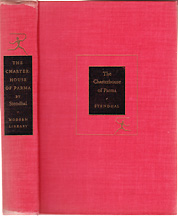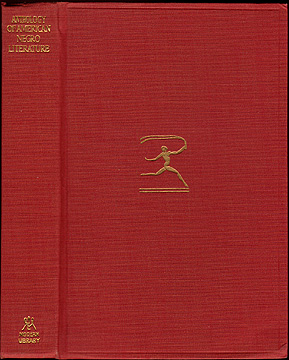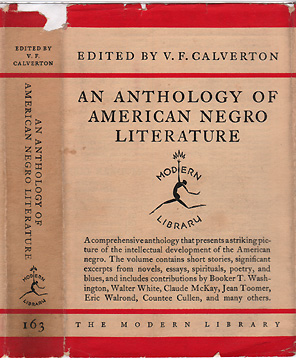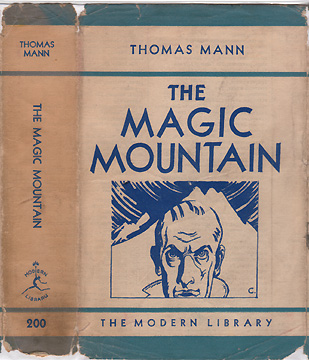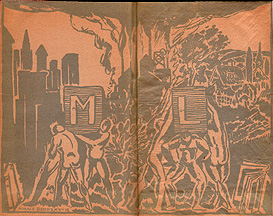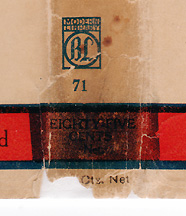Modern Library Dust Jackets and Bindings: 1917-1939
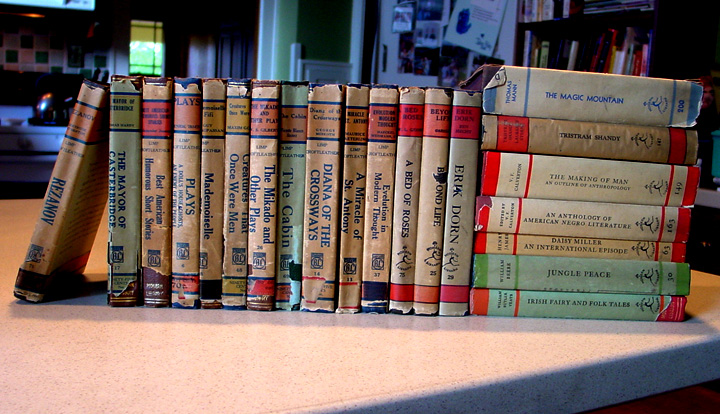
The Modern Library Series was established in 1917 by the
publishers Boni and Liveright (New York). The series highlighted 'modern' (and
mostly European) authors, in comparison to Everyman's Library,
which emphasized 'classic' authors. In 1925 the Modern Library was sold to Bennett Cerf
and Donald Klopfer, and the series eventually became the cornerstone of
Random House publishers.
This page contains details and images of the cache of old Modern Library books
pictured above, as I found them. The books were owned by the same person, and I
paid about $4 for each of them. These books encompass an amazing sample of
nearly all the Modern Library binding and dust jacket variants from 1917 through
the 1930s, including at least one Boni and Liveright copy in DJ from each of the
first four years of the Modern Library: 1917, 1918, 1919, and 1920. A few are
first editions. Most Modern Library 1st editions published after 1925 indicate
"First Modern Library Edition": a list of Modern Library titles that don't state
a first edition can be found at Scot Kamins Modern
Library Collecting WWW Site.
It is unusual to find pre-1930 Modern Library editions in their dust jackets.
It is very unusual to find Boni & Liveright editions in dust jackets: I
found two copies with dust jackets in the 5 years prior to acquiring the eleven
in this collection.
I originally put this page together to share with Modern Library collectors on
the MODLIB email discussion group. I added some details about some of the
authors of the books, as well as a few images from books not in the original
cache to make this page into a basic overview of the major Modern Library
bindings and dust jackets from the beginning of the Modern Library (1917) to
1939, when the larger (and very common) Blumenthal binding was introduced (used
until 1967):
A Brief Digression on the Modern Library compared to Everyman's Library
The Modern Library was undoubtedly inspired by the success of Everyman's Library
(20 million books sold between 1906 and 1924), which predates it by more than a
decade.
Everyman's Library was established by Dent & Sons in 1906 to take advantage of
the many Victorian classics (Tennyson, Browning, Carlyle, Dickens, Huxley, etc.)
falling out of copyright. Everyman's Library was to have an expansive (1000
volume) collection of copyright-free classics in nicely bound yet inexpensive
editions. Dent wrote of Everyman's as a nationalist enterprise, as similar series
existed in France (Biblitheque Nationale) and Germany (the Reclam collection),
but not England. As such, it was really a
collection of established classics, many in new scholarly translations, or back
in print after many years of being unavailable.
Copyright-free texts obviously made for fewer hassles and less expense for Dent.
However, this excluded many modern authors and many American authors...but not all.
Dent and his editor Ernest Rhys did include
American authors: Everyman's was among the
first series to reprint Melville, who was largely unread and unknown in Europe.
Everyman's Library also included American authors such as Hawthorne, Alcott,
Emerson, Cooper, Thoreau, Stowe, Motley, Holmes, Irving, Parkman,
Poe, and others, including some who are now largely forgotten, including
Florence Converse and George Curtis - author of the not quite immortal Prue
and I (#418).
American authors Hawthorne and Emerson are among the first 12 titles in
Everyman's Library.
Conversely, the first 12 Modern Library authors (Wilde, Strindberg, Kipling,
Stevenson, Wells, Ibsen, France, Maupassant, Nietzsche, Dostoyevski,
Maeterlinck, Shopenhauer) do not include a single American author!
The 'Modern' Library was just that - a collection of mostly 'Modern' authors
(and what was 'Modern' obviously flowed from Europe), certainly more 'trendy'
and 'cutting-edge' than the titles in Everyman's. Such a series was certainly
in keeping with the edgy bohemian image Horace Liveright shaped for Boni & Liveright's
publishing efforts.
Most of the Modern Library's initial titles were not in Everyman's (except for
Dostoyevsky's Poor People). Dutton bound and sold Everyman's Library in
the US. Dutton bought 20% - usually 2000 copies - of every printing Dent
produced. When the Modern Library began in 1917, Everyman's had over 700
different titles, many in multiple printings: Dutton sold a large number of
Everyman's editions in the US. The books were the same as the British copies,
but the dust jackets had Dutton (rather than Dent) on the spine thru the 20s.
Dutton also had some unique American Everyman's titles that were not published
in Britain (of more modern authors... possibly to compete with the Modern
Library).
Of course, the Modern Library would begin to add titles by American authors in
the 1920s, and also titles that were not 'modern.' Everyman's Library began to
add titles that were 'modern' in the 1930s.
But it seems fair to say, in a nutshell, that the difference between Everyman's
and the Modern Library was one of 'classic' titles vs 'modern' titles...at least
back when the Modern Library was first published in 1917.
Last updated: 11/14/06
Sources:
Most of the books in the above photo are detailed below. Send any comments or
corrections to me (John Krygier) at jbkrygier@owu.edu
- Books are arranged by age (approximately) going back in time. Think of it as
an archaeological dig into the pile of raw books in the photo above (older copies are
deeper!).
- I made scans of anything that seemed unusual, and note a few corrections for
Toledano's Guide. References to series numbers ("200.1" - the Modern
Library reused numbers after titles were discontinued; the decimal after the
number helps differentiate different titles that used the same number), dust jacket types ("x"),
and dating information are referenced to Toledano's Guide.
- The DJs, in some cases, are a bit tattered! The Modern Library, and other
similar series, were inexpensive books for the common man or woman, and were
read and recycled (as used books) to the extent that few pre-WW2 copies survive with
fine or even very good dust jackets.
Further, the floppy flexible bindings of early Modern Library books, and the
thin paper used in the dust jackets, almost guaranteed that the dust jackets
would not survive. It is safe to say that only a few of some of the B&L
titles in this cache of books exist in dust jackets (in any condition).
First up: TWO mid 1930s Modern Library editions. These binding types and
dust jackets are the most common for the 1929-39 era of the Modern Library. The
books are approximately 6.5" x 4.5" - as are all Modern Library books prior to 1939.
163.1: Misc: An Anthology of American Negro Literature
200.1: Mann: Magic Mountain
1930s era Modern Library editions are bound in balloon cloth. Balloon cloth was "used in
several applications in aircraft such as pliable backings for package racks,
hat racks, etc. Light cotton gauze, woven tightly and with great precision,
is run through a rubber mill; the crude rubber is squeezed through he pores
of the cloth and sheeted on both sides. The rubber is then vulcanized." (Source)
Modern Library dust jackets were either typographical (Anthology example below,
called "B" in Toledano's Guide)
or pictorial (Mann example below, called "P" in Toledano's Guide) during the 1930s.
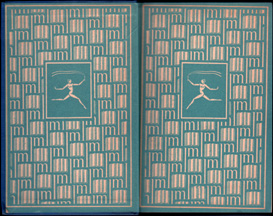
- The Anthology DJ lists 236 titles (1936) and the Mann DJ lists 245 titles (1937).
Information on using titles listed on Modern Library DJs and in back-of-the-book
catalogs for dating can be found at
Scot Kamin's Modern Library Collector's WWW pages.
- The Anthology of American Negro Literature edited by
Calverton (1st Modern Library edition, 1929) was an early and
influential anthology of African American literature. "Those interested in
a detailed survey of the most significant [African American literary anthologies] should consult
Keneth Kinnamon's informative article, 'Anthologies of African-American
Literature from 1845 to 1994,' in Callaloo 20.2 (1997). Although he begins
by examining two collections from the nineteenth century, Kinnamon argues
that the 'pioneer general anthology in the field' is the Anthology of
American Negro Literature (1929) compiled by V. F. Calverton, 'a white
Marxist critic.'" (461). (Source)
The Anthology was revised in 1944 by Watkins, and in print in the Modern Library
until 1970.
- Mann's 900 page (!) tome of ideas and ideals (a prime example of the German
'educational novel'), Magic
Mountain (1st Modern Library edition, 1932) was discontinued
in 1937 because of good sales: Knopf, the copyright holder, wanted to restrict
editions of this title to their own imprints, after the book became a Modern Library
best-seller.
Next: SEVEN mid to late 1920s Modern Library editions, more or less
representing the major binding and DJ types from the first 5 years after Cerf and Klopfer
took over the Modern Library from B&L.
63.1: James: Daisy Miller: An International Episode
44.1: Misc: Irish Fairy and Folk Tales
Two 1929 "transitional" bindings: the bindings look like earlier
leatherette bindings, but are bound in balloon cloth. These bindings
appear on a number of Modern Library titles in late 1928 and early 1929.
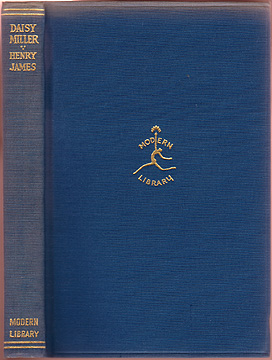
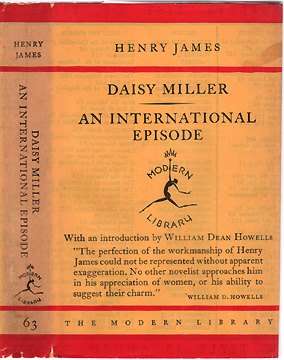
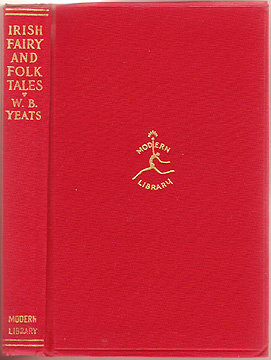
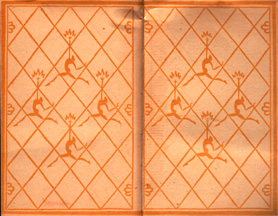
- Both "transitional" bindings are classified as binding #4. Both of these books have
the Bernhard endpapers (bottom, right), which were used from 1925 to 1929. Some transitional bindings
have the Kent endpapers.
- Both DJs list 150 titles (Spring 1929) on a 'B' DJ
- Scot Kamins shows three transitional binding titles (here)
and I have two others (Schreiner, Story of an African Farm and Symonds Life
of Michelangelo).
- Irish Fairy and Folk Tales edited by William Butler Yeats is a standard
anthology, published
in the Modern Library from 1918 to 1970.
- James' two short novels Daisy Miller and An International
Episode were in the series from 1919 to 1934, and this title the only difficult
Modern Library James title (out of six) to find. Daisy Miller was James' first
critical and commercial success.
30.2: Beebe: Jungle Peace
Leatherette bindings were used from 1917 to 1929, then replaced with balloon
cloth. The common 1930s text DJ (type 4) was first used in 1928: thus
there is a year or so where one could find an older-style binding (leatherette)
with a newer DJ. A variation on the transition in ML books ca. 1929.
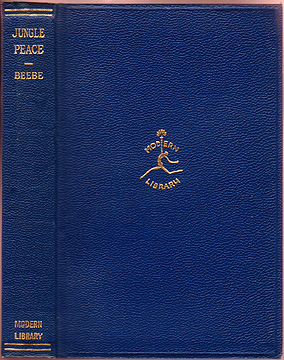
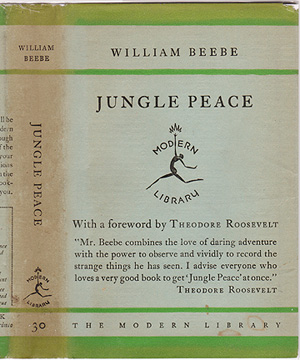
- Leatherette binding (#4), 'B' DJ, with Bernhard endpapers
- DJ lists 150 titles (Spring 1929) on a 'B' DJ (typical of 1930s); the
catalog in the back of the book dates the book to Fall 1928. Modern Library books
often have newer DJs on them, as Random House and dealers would spiff up stock with
new DJs.
- Beebe's Jungle Peace with an introduction by Theodore Roosevelt, was
in the Modern Library from 1925 to 1940. "Beebe pioneered the concept of studying
wildlife in one designated spot, hence his chapter, 'A Yard of Jungle.' This was a
revolutionary concept. Instead of exploring and encountering wildlife at random,
for one week Beebe specifically decided to observe one yard of jungle and everything
that happened inside that one yard. His findings were significant." (Source)
147.1: Sterne: Tristram Shandy
A First Modern Library Edition, 1928 of Sterne's classic Tristram Shandy.
This edition was probably the only leatherette edition of this title, as
balloon cloth replaced leatherette in 1929. This binding and DJ ('b')
are common to all Modern Library editions published from 1926 to 1928,
and the DJ mimics a design common to the Modern Library since its
inception in 1917.
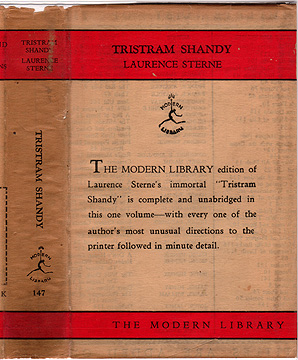
- Leatherette binding (#4; same as Jungle Peace above) with Bernhard
endpapers and DJ type "b": Toledano's Guide lists the later "B" DJ only.
The "b" DJ seems to be the correct DJ type for this first. The catalog in
the book and on the DJ verso dates it to Spring of 1928
- This title and edition are unique for having bound-in elements: the
piece of real marbleized paper (bound in after p. 202, image below) was
unique to the 1st edition of this title. Subsequent editions omitted
the marbelized paper, but a printed facsimile was included in editions
beginning in the mid 1940s (information from Gordon Neavill via MODLIB).
The marbelized paper is part of the novel: "It is referenced in an
address to the reader at the end of the immediately preceding Chapter 36
(of Book III): '... you will no more be able to penetrate the moral of
the next marbled page (motley emblem of my work!) than the world with
all its sagacity has been able to unravel the many opinions,
transactions, and truths which still lie mystically hid under the dark
veil of the black one.'" (quote from Bob Riedel via MODLIB)
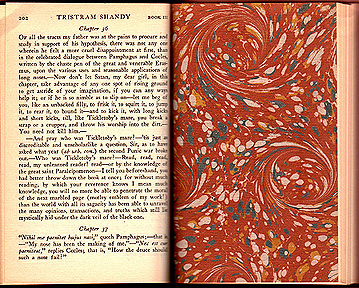
- This title also had a bound-in Modern Library catalog in the back of
the book. Modern Library catalogs were typically printed in the back of
the book if there were enough left over pages in the last signature. If
there were not enough pages, the catalog was omitted. In the case of
Tristram Shandy there were not enough pages to print the catalog
in the last signature, but a copy was bound in: "This list is what
bibliographers call an "inserted fold" ... the blank page [592] is the
last page of the last gathering, and the 4-page ML list was tipped in. I
guess they figured as long as a sheet of marbled paper was being tipped
in they might as well tip in a ML list as well." (quote from Gordon
Neavill via MODLIB).
- Sterne's Tristram Shandy was in the Modern Library from 1928 to 1970.
25.2: Cabell: Beyond Life
75.1: George: A Bed of Roses
29.1: Hecht: Erik Dorn
Three 1925-27 Modern Library editions, published right after Cerf and
Klopfer bought the Modern Library from B&L. "x" DJs lack
the ML running torch-bearer on the front of the DJ, which apears on Modern
Library DJs around 1926. These three books illustrate how fleeting literary fame
can be: neither Cabell, George, or Hecht are read nor remembered today, yet
their literary status in the 1920s was great enough for their work to be included
in the Modern Library.
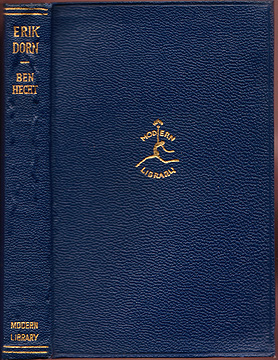
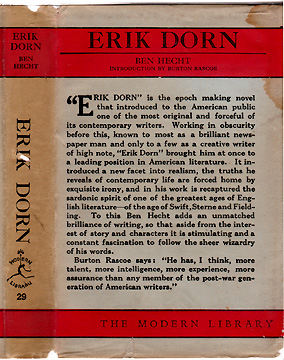
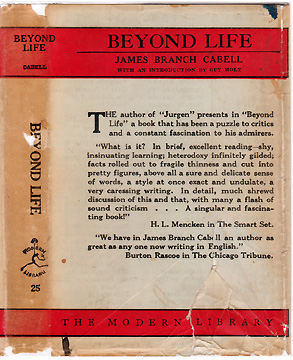
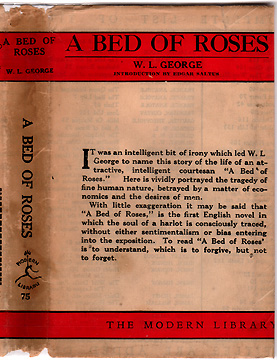
- All three are leatherette (binding #4) with the "x" DJ.
- Toledano's Modern Library Guide does not show a "x" DJ for these three ML
titles (the Guide shows only later "b" DJs). The catalog in the book
and on the DJ of Eric Dorn and A Bed of Roses dates the
books to Autumn 1927, suggesting that the "x" DJ type was used from
1925-27 (rather than 1925-1926 as noted in Toledano's Guide). Cabell's
Beyond Life dates to Autumn 1926.
- James Branch Cabell's Beyond Life was one of three of his titles in the Modern Library,
and was in print from 1923 to 1935. Beyond Life was "suppressed" from
January 14, 1920 to October 19, 1922, and the 1923 Modern Library edition
undoubtedly benefited from the controversy over the book.
Cabell seems largely unreadable today, but was very popular (and
controversial) in the 1920s and 30s.
- W (Walter) L (Lionel) George's A Bed of Roses, about a prostitute,
was in the Modern Library 1919 to 1934. The book must have been popular with
critics and readers at the time of publication, but Mr. George and his novel have
now faded into obscurity.
- Ben Hecht's Erik Dorn was in the Modern Library from 1924 to 1937. Erik
Dorn was the first Modern Library title to use the number 29: that's odd,
as the first title to use number 28 (Flaubert's Madam Bovary) and 30
(Stephen's Mary Mary) were published in 1917. Apparently, a "Ghost
Title" (Best French Epigrams) was to be number 28, and it held that
number (and was never published) until Erik Dorn was first published in
1924. Hecht was a successful
Hollywood screenwriter in the 1920s through the 1950s.
Finally: ELEVEN Boni and Liveright Modern Library editions. I organized
them into 4 groupings, based on the different prices printed on the DJ spines:
95 cents, 85 cents, 70 cents, and 60 cents (oldest last). Many of the earlier DJs have
'official' price increases imposed over the original price printed on the DJ
spines, clearly revealing the numerous changes in ML prices from 1917 to
1920. The differences between Boni and Liveright DJs and the early
Cerf and Klopfer DJs is primarily on the spine (different logo, price) but
the front of the B&L DJs also have thicker lines surrounding the red bars,
and different typography.
48.1: Gorky: Creatures that Once Were Men
17.1: Hardy: The Mayor of Casterbridge
69.1: Ibanez: The Cabin
87.1: Misc: Best American Humorous Short Stories
Four 1919-20 B&L editions. All have "Ninety-five Cents net." on the
DJ spine. Ibanez's The Cabin was discontinued (along with a few other
poorly selling titles) when Cerf and Klopfer took
over the Modern Library, so it is available only in a B&L edition. Notice that
the Gorky and Hardy copies below do not say "Limp Croftleather" on the DJ spine;
the other 9 B&L copies do. According to Gordon Neavill "This ambiguous and apparently made-up
phrase was dropped after April 1925 when the Federal
Trade Commission issued a cease and desist order prohibiting
the Modern Library from using the word 'leather' in
connection with its bindings except in combination with
words like 'imitation,' 'substitute,' or 'artificial.'" (Modlib discussion group,
6/6/02).
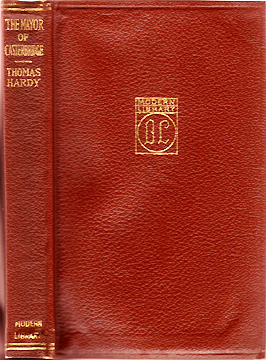
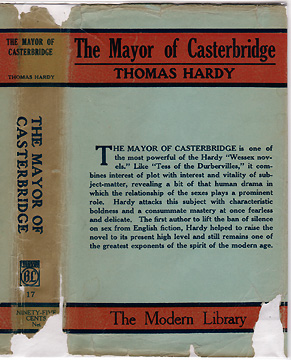
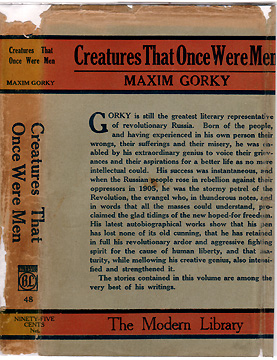
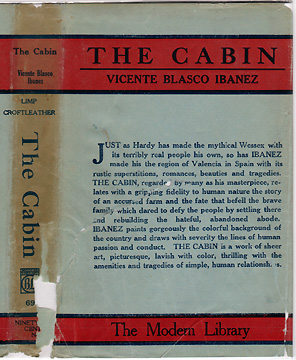
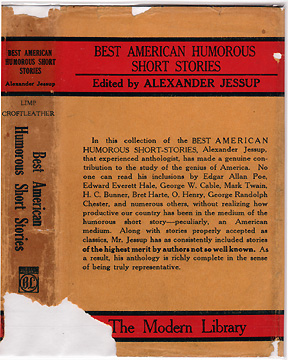
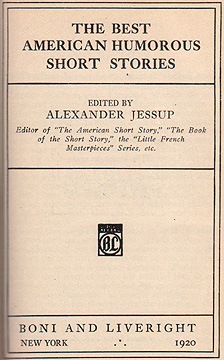
- All four are leatherette Boni and Liveright (binding #2, used 1917-25) with the "BL" DJ and
Brodzky endpapers (below left). The only thing that differentiates
binding #2 from #3 (used on some titles 1923-25) is that #3 has a
different logo on the front of the book (below right):
- Hardy's classic was in the Modern library until 1970. This copy says "First Printing, July 1917, Second Printing, September 1917"
on the reverse of the title page. Alas, with .95 on the DJ spine, the DJ
suggests a post 1920 copy (1920 is when the price went up to .95 cents
according to Toledano's Guide, p. 157). The binding (#2) also suggests this
is not a 1917 edition: the printing information must have not been updated
(nor removed) after the first two printings. The Modern Library seldom
included printing information nor dates of publication (which is why the
catalogs on the DJs or in the back of the books are vital for dating ML books).
- Gorky's collection of short stories was in the series from 1918 to
1934.
- This copy of Ibanez's early novel seems to be a 1st, but
this is a tough one to determine the 1st ed., according to Toledano's Guide.
The date of the book could be 1919 or 1920. Ibanez is best known for
The Four Horsemen of the Apocalypse. The Cabin was less popular,
but more literary than The Four Horsemen of the Apocalypse, and
this might explain its inclusion in the Modern Library. On the other hand,
the Modern Library sometimes found it difficult to get permission to publish
books that were still selling well for other publishers, and had to resort
to lesser known works if they were to include a particular author in the series.
- This copy of the anthology Best American Humorous Short Stories
says "Boni and Liveright New York 1920" at the bottom of
the title page. I don't recall seeing a date on the title page on other
B&L copies. This copy is probably a 1st edition. This anthology was revised
by Linscott in the mid 1940s and in print in the Modern Library until 1970.
It is amazing how unfunny some of this humor from the past can be!
71.1: Atherton: Rezanov
11.1: Maeterlinck: A Miracle of St. Antony
8.1: Maupassant: Mademoiselle Fifi
14.1: Meredith: Diana of the Crossways
37.1: Misc: Evolution in Modern Thought
Five 1919 B&L editions. All have "Eighty-five Cents net." on the
DJ spine. Atherton's Rezanov was discontinued when Cerf and Klopfer took
over the Modern Library, so it is available only in a B&L edition.
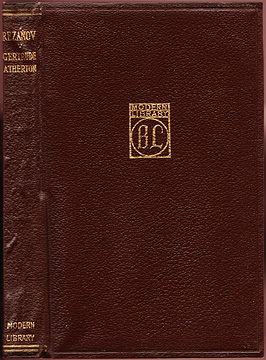
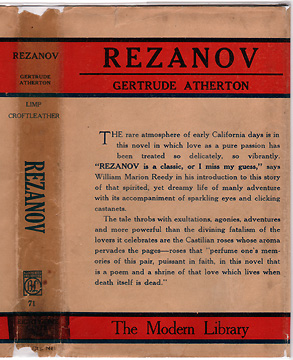
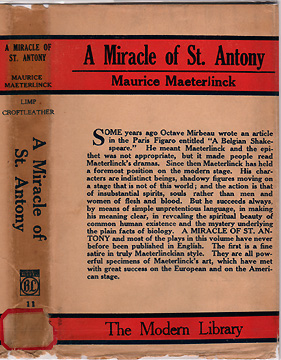

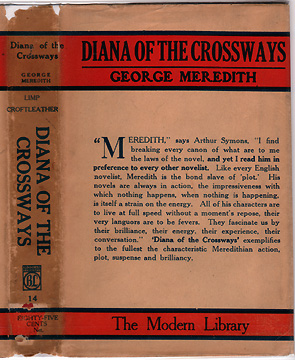
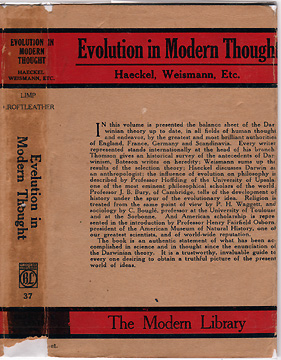
- The close up scan (below) of the bottom of the spine
of the Atherton title shows how the price was blocked out and what probably was
"95 cts. net" printed below:
- Gertrude Atherton was among the first women writers from America's west coast,
yet she is largely forgotten today. "In many ways a shallow
thinker, she missed the chance to meet Oscar Wilde because she didn't like his
looks. Jealous of her own reputation, she spread the rumor that Edith Wharton
didn't actually write The House of Mirth. Thinking herself to belong to
aristocracy, she looked down on ordinary people, believing that there was merit
in monarchy." (Source)
Gertrude seemed to run against the very philosophy of the Modern
Library! This copy of Rezanov does not have
the fancy title page shown on p. 77 of Toledano's Guide.
- Maupassant's collection of short stories, first published in the Modern
Library in 1917, was combined with a second
set of short stories (Love and other Stories) in 1932 to create a single
volume called, appropriately, Short Stories. The title of the collection
was changed to Best Stories in 1940, re-edited by Commins in 1945, and
remained in the series until 1970.
- The Belgian playright and Nobel Prize winner (1911) Maurice Maeterlinck had
this collection of short
plays in the Modern Library from 1917-28. Toledano's Guide has "St. Anthony"
rather than "St. Antony" as the title of this book.
- Meredith's Diana of the Crossways was in the Modern Library series
from 1917 to 1956.
- The anthology Evolution in Modern Thought compiled a range of short pieces
reviewing the impact of Darwin's theory on the social and physical sciences. The
anthology, first published in 1917, revealed the Modern Library's
perspective on contemporary conflicts over Darwin's Theory. This anthology
was discontinued in 1929. The DJ paper on this book is about twice as thick
on paper on the other copies: if all the early ML DJs were printed on such heavy
paper more early DJs may have survived.
26.1: Gilbert: Mikado and other Plays
A Fall 1918 B&L copy of Gilbert's Plays. A note on the reverse of the title
page says that "'Pinafore' will be included in a second volume of Gilbert's
Plays, now in preparation."
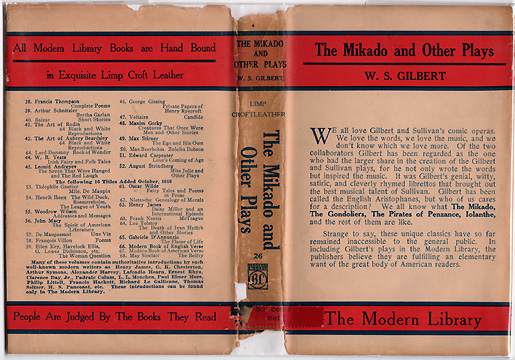
- This copy is in B&L binding #2 with the "BL" DJ and
Brodzky endpapers. This
one has "70 Cents Net." on the DJ spine, which would make
it 1918. Also, it has B&L catalog C5, which would make it Fall of 1918.
This copy has a sticker with "85 cents net" affixed
over the price on the DJ. The sticker has stamp-like perforations.
- Gilbert's two volumes of plays in the Modern Library were combined to
form The Complete Plays of Gilbert and Sullivan, a Modern Library Giant,
in 1937. This copy has a DJ back cover which must have been used between styles a
and b shown on p. 164 of Toledano's Guide.
6.1: Ibsen: Plays: A Doll's House, Ghosts, an Enemy of the People
Ibsen's Plays is an example of a Boni and Liveright in a DJ from the first year
of the Modern Library's existence: this copy was published September
1917. It has the early 'blank' spine (lacking "Modern Library" and the
gold bars) and marbelized endpapers (below right).
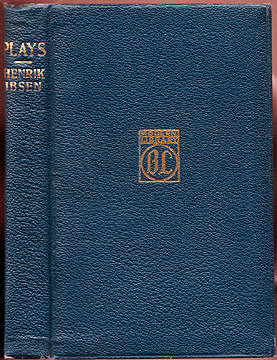
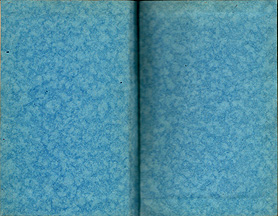
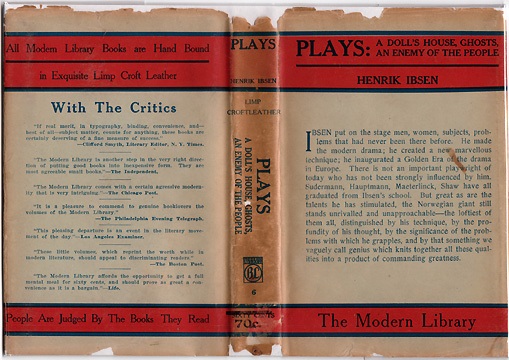
- Ibsen's Plays leatherette Boni and Liveright (binding #1) with the "BL" DJ and
the marbelized endpapers. This
copy has "Sixty Cents Net." on the DJ spine. The book has B&L catalog C3,
making it September of 1917. This copy has an overprint with "70c" printed
over the price on the DJ.
- Many variations of Ibsen's plays were included in the Modern Library from
1917 to 1970. This book also has a
different DJ back cover, which must have been used after a
shown on p. 164 of Toledano's Guide. As the back of the DJ has some
interesting reviews of the then new Modern Library, I increased its size
to make it easier to read:

This page may all seem a bit nutty, but it was really fun sorting through
this great bunch of old Modern Library books.
JK


